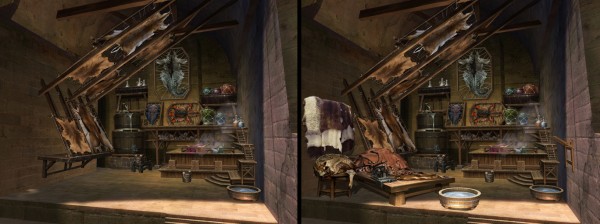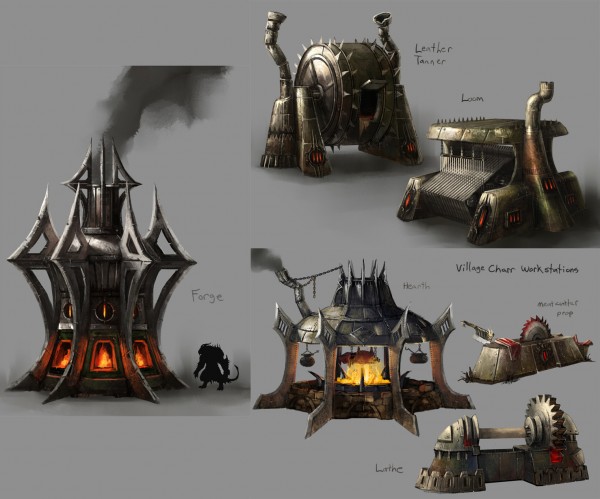Andrew McLeod Talks Crafting in GW2
I'm Andrew McLeod, one of the Game Designers responsible for creating an in-depth but accessible crafting system for Guild Wars 2. We've added crafting to the upcoming PAX East demo build, so this seems like the perfect time to talk about it.
Disciplines[edit]
In Guild Wars 2, there are eight crafting disciplines players can choose from.
- Weaponsmith – Weaponsmiths craft melee weapons, such as swords, axes and hammers.
- Huntsman – Huntsmen craft ranged weapons like bows and pistol, as well as torches and warhorns.
- Artificer– Artificers craft magical weapons such as staves and scepters
- Armorsmith – Armorsmiths craft heavy armor pieces.
- Leatherworker – Leatherworkers craft medium armor pieces.
- Tailor – Tailors craft light armor pieces.
- Jewelcrafter – Jewelcrafters craft jewelry, such as rings and necklaces.
- Chef – Cooks can prepare food which characters can eat for temporary combat buffs.
In addition, most crafters can create upgrades for their gear. For instance, a weaponsmith can craft a handle which can be attached to melee weapons to give them a chance to poison enemies.
Characters can be proficient in up to two crafting disciplines at a time. We feel that this allows players to have a good variety in the items that they can craft, but still maintains player interaction and exchange. It also gives a stronger focus on the specifics of what you can craft- especially with the depth and size of each of our crafting professions.
Although a character can only have two disciplines at a time, they can change their crafting disciplines by visiting the master craftsmen NPC that can be found in all major cities. When you change back to a crafting discipline that you've previously learned, you regain your skill level and known recipes from that discipline, but the cost of changing disciplines increases with the skill level in that discipline.
Gathering[edit]
Before you can craft new items, you need to get the raw materials needed for crafting. The basic materials needed for crafting depends upon the crafting discipline, but there are three ways you can obtain crafting materials:
- Salvaging kits— Available from merchants, salvaging kits allow you to salvage crafting materials out of old or unwanted items.
- Looting—You have a chance of finding appropriate crafting materials like hides or trophies when you loot slain enemies.
- Harvesting—Ore veins, plants, and trees can be found around the world and harvested for materials.
Characters can gather all types of crafting materials, and gathering nodes in Guild Wars 2 are not exclusive, or used up after a player gathers materials from it. If you've played other MMOs, you may have felt frustrated when trying to gather crafting materials; you're running around zones trying to find nodes, only to have someone beat you to the node, or take the resources while you're fighting an enemy that attacked you before you could gather them. In Guild Wars 2, each node can be gathered by every player, so when you see a rare node off in the distance, you don't need to abandon what you're doing to try and beat other players to it.
We decided to make gathering available for all characters for a couple major reasons. First, we wanted gathering nodes to be sought after by every player, so that when players are grouped together they don't need to feel guilty by making the group wait for them while they run off after an ore vein on the side of the road. Secondly, gathering professions are often used for economic gain, through selling materials to other players, and we didn't want crafters to have to sacrifice their economic potential in order to be able to craft gear for themselves and friends.
Crafting[edit]
Crafting stations can be found in cities and major outposts around the world. A woodworking bench is used to saw logs into planks, while a sword is created at an anvil. When interacting with a crafting station, you are presented with an interface through which you can combine up to four types of materials. When the correct items for crafting an item are added to the interface, the resulting item can be crafted.
If you haven't previously crafted that item, you discover the recipe for that item, allowing you to easily view the correct combination to recreate the item. Some basic recipes are automatically learned by characters, but the recipes for most items must be discovered by the crafter. A few recipes can only be learned from a trainer or from drops in the world.
We decided to go with a discovery system for learning recipes so as to allow crafters to distinguish themselves. When there is a static list of recipes learned from a trainer, every character with that crafting discipline is the same. However, with a discovery system, players that spend time and effort on their crafting disciplines have a way to distinguish themselves.
Leveling up your crafting skill uses an experience system—each item you craft is worth an amount of experience. There are 400 skill points in each discipline, though crafting items will often give multiple points worth of experience. Our intent is that you should never have to make something you consider worthless while leveling a crafting discipline.
I hope you've enjoyed this look at crafting in Guild Wars 2. As you can see, the crafting system we've created really reflects our philosophy of cooperative, accessible gameplay.



